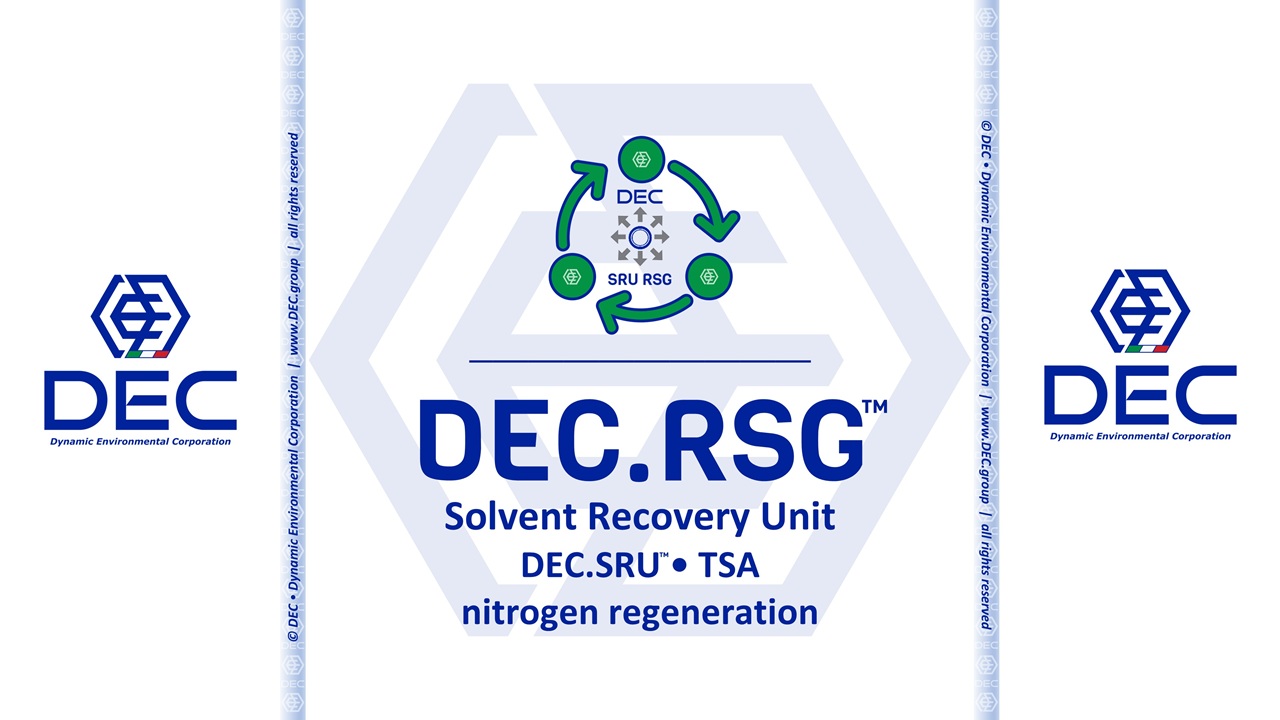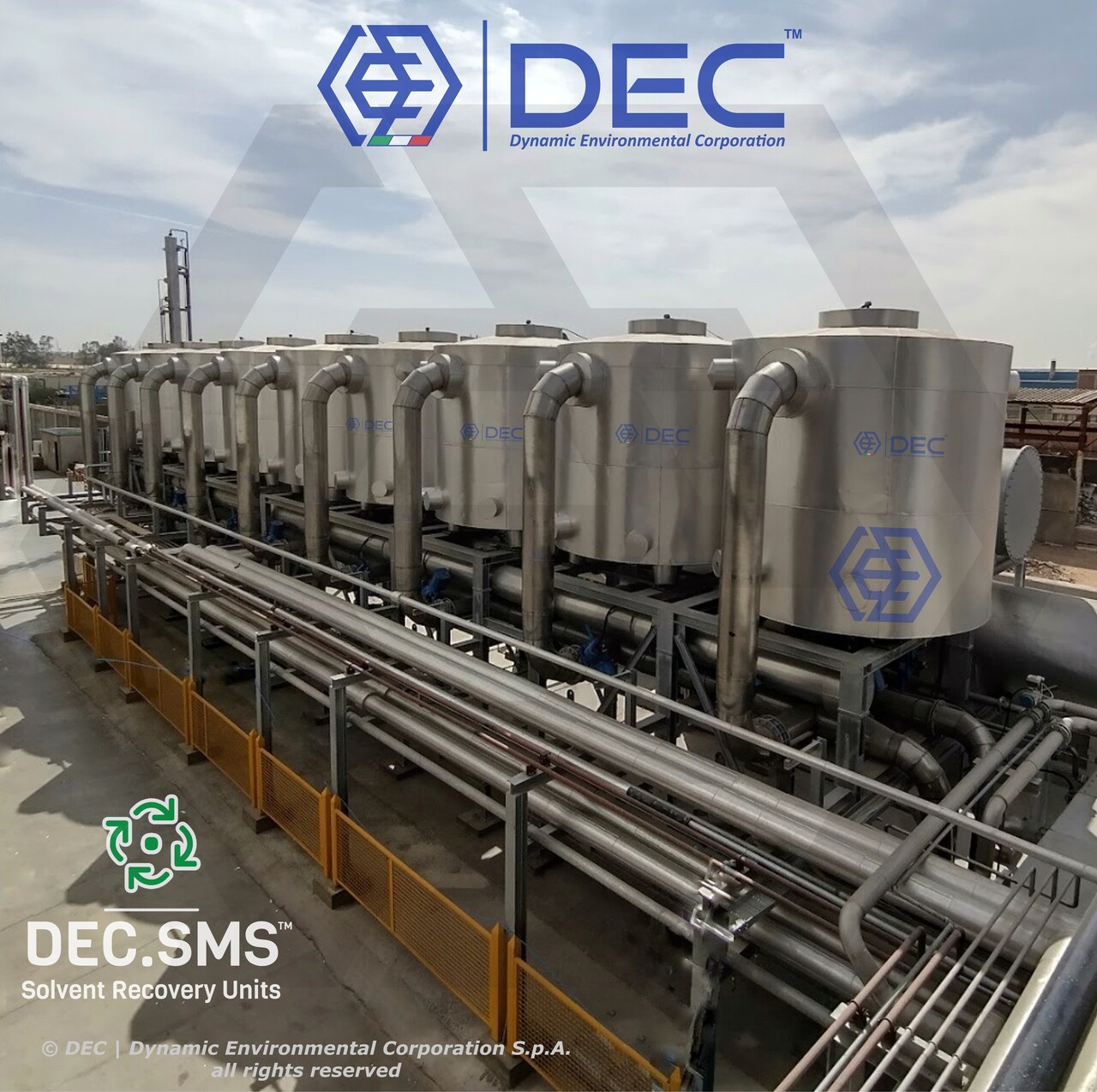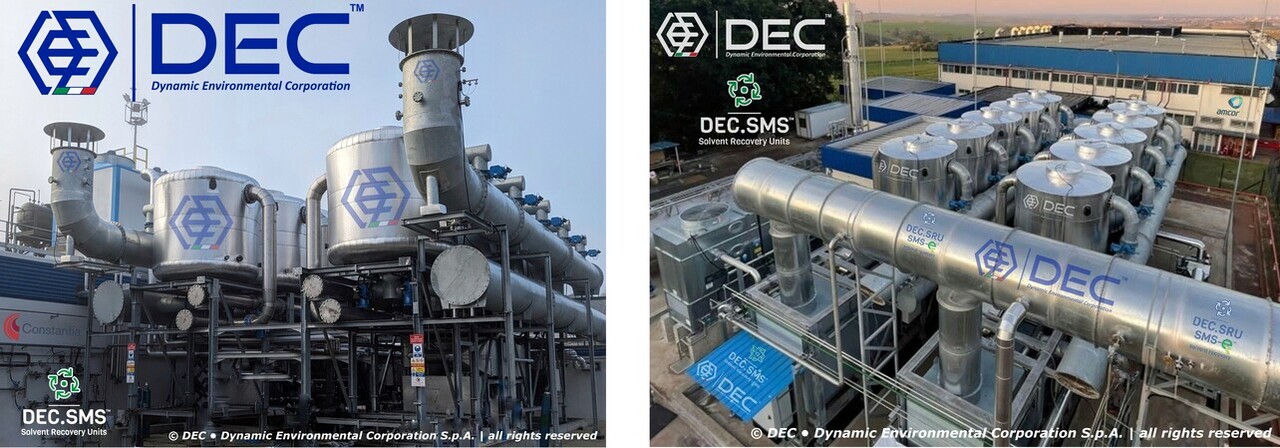
Solvent Recovery Unit ♻️ activated carbon
Nitrogen regeneration (TSA) | DEC.RSG™ | DEC.SRU™
Ready to cut VOC emissions and recover valuable solvents, wile complying with the latest environmental regulations and directives? Activated carbon Solvent Recovery with inert gas (nitrogen) regeneration is your ultimate solution in VOC emission control technologies. This advanced process leverages nitrogen to regenerate activated carbon, capturing solvents like ethyl acetate and ethanol with precision, slashing emissions, and enhancing sustainability. Curious about how activated carbon solvent recovery works with nitrogen or ready to invest in activated carbon solvent recovery units? This cost-effective, eco-friendly technology excels in industries like packaging and chemicals. Click to discover top VOC control systems and learn why nitrogen regeneration beats steam methods hands-down!
Solvent Recovery Units, based on activated carbon adsorption, hot inert gas (N2, Nitrogen) regenerated, are using a core technology which has been proven in thousands industrial applications, treating variable volumes of gaseous effluent (typically 5.000 ÷ 1.000.000 Nm³⁄h); the regeneration of the adsorption media (activated carbon) is using Nitrogen as desorption media [DEC.RSG™ process, alternating different phases, as adsorption and TSA (thermal swing) regeneration, with N2, Nitrogen desorption], determining this process to be the ideal choice and the top performer when dealing with variable SLA volumes and variable (low-medium-high) concentrated VOC streams (mono and multi-solvent).

Back in 1980s, DEC developed the revolutionary steamless technology (DEC.RSF™) for regenerating the adsorbent, using an inert gas. Today, this legacy lives-on in the powerful DEC.RSG™ (and its versatile high performance variant DEC.RSX™). With hundreds of successful applications across diverse industries and continents, DEC.RSG™ tackles both mono-solvent and multi-solvent systems, delivering direct recovery of anhydrous solvents with zero process water discharge.
For different process conditions, and/or type of solvents, and/or SLA flowrates, please check the available solvent recovery processes.
 |
 |
SRU RSG™ • challenging solvent recovery made possible
Azeotropes, where solvents and water mix inextricably (binary and ternary - e.g. acetates and alcohols ), often pose a recovery challenge: DEC.RSG™ steps in as a game-changer, allowing the direct recovery with a no compromise purity. With its ability to tackle azeotropes and various miscibility challenges, DEC.RSG™ redefines solvent recovery allowing the application of this sustainable solution to a wide range of industrial applications.
The DEC.RSG™ process also represents the solution for the recovery of problematic solvents (due to their volatility, flammability, or reactivity), which are deemed "NOT RECOVERABLE" or "DANGEROUS": DEC.RSG™ can handle solvents that other conventional methods might struggle with, expanding your recovery options. Typical application, is the recovery process of ketones (such as MEK - methylethylketone): check for our DEC.FPS™ process control modules.
SRUs (Solvent Recovery Units) that utilize a nitrogen-regenerated TSA (Temperature Swing Adsorption) cycle are highly regarded for their robust design and sustained performance. This regeneration method contributes significantly to their durability and extended operational lifespan, making them a reliable choice for long-term solvent recovery applications. Their ability to consistently perform over prolonged periods minimizes downtime and reduces overall maintenance requirements.
The Technology Readiness Level (TRL) of DEC SRUs equipped with DEC.RSG™ process reached a high level of maturity, classified nowadays as TRL 9 (actual system proven in operational environment, according to ISO 16290:2013): the DEC.SRU™ technology is commercially available and has been proven to work effectively in real-world applications.
Solvent Recovery Unit (SRU RSG™) • concepts
A Solvent Recovery Unit (SRU | SRP | SRS) consists of a specifically designed DEC.SBC™ static concentrator, coupled with an “in-situ” regeneration process.
A static concentrator employs an adsorbent to adsorb contaminants (VOCs, solvents) from a gas (SLA, solvent-laden air): selected adsorbent shall be a highly porous material with a large surface area, which makes it an effective adsorbent (typically DEC.ACA™ • activated carbon). The adsorbent is packed into a series of adsorbers, and the gas stream is passed through the adsorbers in sequence. As the stream passes through each adsorber, contaminants are adsorbed onto the adsorbent. Once an adsorber is saturated with contaminants, it is taken offline and regenerated. Regeneration involves both mechanical and thermal energy to be delivered to the adsorbent: these combined energies will drive off the adsorbed contaminants (known as desorption). These contaminants are then driven through a condenser (heat exchanger), for direct condensation and reuse. Once desorption cycle is completed, the adsorbent will be ready for the next adsorption cycle.
 |
 |
the solvent recovery process (SRU RSG™) • how it works?
A Solvent Recovery Unit (SRU) is an industrial system designed to capture and reclaim solvents from vapor phase waste streams (SLA, Solvent Laden Air): its primary objectives are to minimize environmental impact, adhere to industrial emission regulations, promote a circular economy, contribute to DECarbonization, and generate substantial cost savings by reducing reliance on new solvent purchases, thereby lowering operational costs.
The fundamental principle governing solvent recovery units is adsorption, most commonly utilizing activated carbon. The typical process unfolds in several stages:

solvent recovery (SRU RSG™) • hydrolysis minimized, recovery maximized
DEC.RSG™'s "dry" Nitrogen-based desorption process ensures a negligible impact from hydrolysis reactions, safeguarding solvent integrity and purity for unprecedented recovery efficiency.
direct anhydrous recovery of solvents
DEC.RSG™ units can be equipped with DEC's exclusive gas-phase pre-dehydration process, based on DEC's exclusive selective desorption algorithm (DEC.PHD™): this innovative process offers the advantage of directly recovering a mixture of solvents with an extremely low water content, without the drawbacks of condensing / freezing important quantities of water, delivering outstanding energetic advantages and avoiding waste-water (contaminated by solvents) disposal or additional treatment, minimizing operational and environmental impact.
For increased dehydration performances, additional modules are available [see dehydration modules (DEC.ADM™) and/or distillation systems (DEC.DST™)].
The Solvent Laden Air (SLA) stream processed by the SRU carries not only VOCs but also water vapor (humidity), typically ranging from 5 ÷ 18 g/m³ depending on season and location. Partial adsorption of humidity on the activated carbon, can affect the purity of the recovered solvent: DEC.RHC™ modules address this challenge by reducing the impact of humidity and optimizing energy consumption.
solvent recovery (SRU RSG™) • best-in-class recovery efficiency
Not only does DEC.RSG™ offer exceptional solvent recovery rates (ultra-low TVOC stack emissions), but it also stands as a beacon of sustainability. Its innovative design achieves the lowest emission values in the industry, ensuring minimal environmental impact, and compliance with any global VOC emission standards. This means you can protect the planet, while maximizing your solvent recovery, achieving a recovery yield of up to 99% or more.
solvent recovery (SRU RSG™) • best-in-class energy efficiency
Efficient DEC.ERS™ (Energy Recovery Systems) are available, to lower operating costs (OPEX): check DEC.ULP™ (Ultra-Loop) modules, for more details.
DEC.RSG™ with DEC.ULP™ (Ultra-Loop) modules delivers unmatched operational and maintenance cost savings compared to any other technology on the market: up to a 30% reduction in O&M costs compared to traditional solvent recovery methods.
solvent recovery (SRU RSG™) • simplicity meets power: expert performance, without complexity
While DEC.RSG™ solvent recovery units boast advanced technology and impressive capabilities, their operation and maintenance remain surprisingly straightforward. You don't need a team of dedicated specialists to harness its power. DEC SERVICE remotely monitors your SRU, ensuring optimal performance and freeing your resources for other priorities. This seamless remote support (DEC.HDS™) allows you to run the SRU efficiently with minimal operator involvement. It's a testament to DEC's commitment to making cutting-edge technology accessible and user-friendly, letting you focus on what matters most while your SRU quietly delivers exceptional performances.
solvent recovery (SRU RSG™) • choose from our Smart Modular or Custom Built Systems
DEC Solvent Recovery Units (SRUs) are available in both skid modular layout (DEC.SRU_SMS™ • Smart Modular Systems, pre-built and pre-tested at our workshops) or in full customizable version (DEC.SRU_CBS™ • Custom Built Systems, with on-site erection).
get a free consultation
If you are looking for a reliable and efficient solvent recovery unit, DEC.SRUs™ (Solvent Recovery Units) are the right and best option: DEC.SRUs™ are the most advanced and reliable Solvent Recovery Units on the market, with processes, configurations and options to meet the needs of different applications, present and future challenges.
Contact DEC for a free consultation: we can help you assess your needs and recommend the best SRU for your operation.

solvent recovery (SRU RSG™) • LTKW
Dive into the world of VOC emission control: How does activated carbon solvent recovery work with nitrogen regeneration and nitrogen regeneration process in solvent recovery technology explain the science; benefits of inert gas regeneration in VOC emission control and nitrogen regeneration benefits for VOC solvent recovery highlight advantages; activated carbon solvent recovery systems for VOC control and VOC emission control with nitrogen-regenerated activated carbon offer solutions; inert gas nitrogen solvent recovery for industrial VOCs and nitrogen-based solvent recovery for VOC control industries target applications; how to implement activated carbon solvent recovery with nitrogen and guide to nitrogen regeneration in VOC emission control systems provide how-tos; best VOC emission control technologies using activated carbon and VOC emission reduction with nitrogen-regenerated solvent recovery showcase top tech; activated carbon solvent recovery equipment with inert gas and buy activated carbon solvent recovery unit with nitrogen drive purchases; comparing inert gas regeneration to steam in solvent recovery and inert gas regeneration techniques in activated carbon systems compare options; activated carbon VOC control systems with nitrogen regeneration and solvent recovery solutions for VOC emissions using nitrogen deliver system insights; while how inert gas improves activated carbon solvent recovery and activated carbon regeneration with inert gas for VOCs round out the benefits. Click to master VOC control today!
